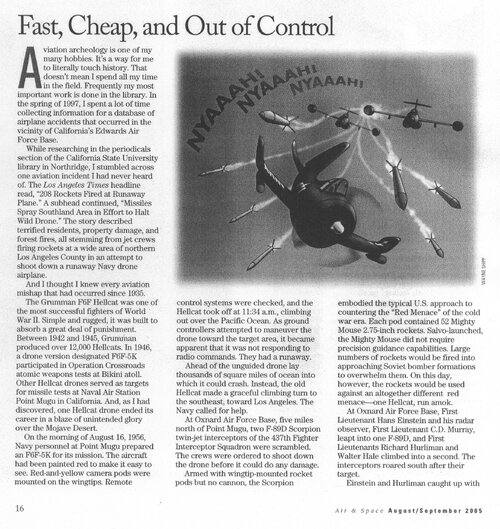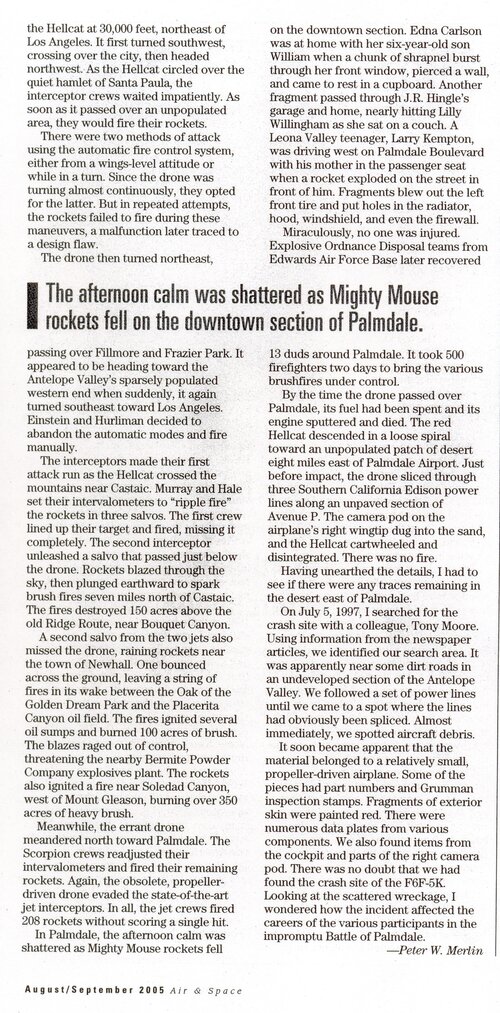You are using an out of date browser. It may not display this or other websites correctly.
You should upgrade or use an alternative browser.
You should upgrade or use an alternative browser.
The Battle of Palmdale – WW2 Drone Hellcat vs F-89 Scorpion Jet Interceptors
- Thread starter Justo Miranda
- Start date
BlackBat242
OK, I changed my personal text ;)
- Joined
- 10 April 2013
- Messages
- 1,482
- Reaction score
- 4,292
Colonial-Marine
UAVs are now friend, drones are the real enemy.
- Joined
- 5 October 2009
- Messages
- 1,472
- Reaction score
- 1,324
Would have it been possible to fit these rockets with proximity fuzes? How was the fire control system supposed to work for the crew, did a gunsight automatically account for the range determined by the radar?
It definitely doesn't give much confidence in the rocket armament of some of these early interceptors. Sure a Soviet bomber is a bigger target, but it would also be shooting back if the interceptors got too close which tends to have a disruptive affect on aiming.
It definitely doesn't give much confidence in the rocket armament of some of these early interceptors. Sure a Soviet bomber is a bigger target, but it would also be shooting back if the interceptors got too close which tends to have a disruptive affect on aiming.
Yes, the Army later developed the M429 VT fuze. However, this was late-Vietnam era and would detonate itself due to interference if you fire more than one at a time.Would have it been possible to fit these rockets with proximity fuzes? How was the fire control system supposed to work for the crew, did a gunsight automatically account for the range determined by the radar?
It definitely doesn't give much confidence in the rocket armament of some of these early interceptors. Sure a Soviet bomber is a bigger target, but it would also be shooting back if the interceptors got too close which tends to have a disruptive affect on aiming.
There just wasn't a compelling reason to give F-89s a VT fuze when the weapons system was only a stopgap until actual missiles showed up.
War Thunder gave the (premium!) F-89D VT fuzes but that is its won separate thing that I argued about elsewhere
That story is so baffling... I wonder whether they should have tried the old trick used by Spitfires against V-1s: wingtip to wingtip.
... then again, it also happened to F-102s. When they went chasing cruise missiles (Matador or Snark, can't remember) gone rogue, and never caught up. One of the cruise missiles was later found... in south america jungle.
... then again, it also happened to F-102s. When they went chasing cruise missiles (Matador or Snark, can't remember) gone rogue, and never caught up. One of the cruise missiles was later found... in south america jungle.
Manuducati
ACCESS: Secret
- Joined
- 25 November 2020
- Messages
- 332
- Reaction score
- 1,065
That story is so baffling... I wonder whether they should have tried the old trick used by Spitfires against V-1s: wingtip to wingtip.
... then again, it also happened to F-102s. When they went chasing cruise missiles (Matador or Snark, can't remember) gone rogue, and never caught up. One of the cruise missiles was later found... in south america jungle.
Interesting story for sure (but maybe not the same one as they do not mention the F-102 interception)!
The Day They Lost the Snark | Air & Space Forces Magazine
Nearly 50 years ago, a big red aircraft made an unexpected landing in the Amazon.
A_Random_Guy
ACCESS: Confidential
- Joined
- 24 May 2022
- Messages
- 72
- Reaction score
- 135
A VT fuze on the rocket would eliminate most of its lethality against a bomber. The rocket penetrates through the skin then explodes, destroying the aircraft primarily by structural failure from the blast. A proximity fuzed weapon generally kills by striking critical components with fragments. In a bomber the volume fraction of these components is far smaller than in a fighter so fragments are less likely to score a debilitating blow. Continous rod warheads were created to have this structural failure effect while utilizing a proximity fuze but even then it was far less reliable.Would have it been possible to fit these rockets with proximity fuzes? How was the fire control system supposed to work for the crew, did a gunsight automatically account for the range determined by the radar?
It definitely doesn't give much confidence in the rocket armament of some of these early interceptors. Sure a Soviet bomber is a bigger target, but it would also be shooting back if the interceptors got too close which tends to have a disruptive affect on aiming.
They developed spin-stabilized 5" rockets (which just didn't work) and explored mounting VT fuzes to these as well as HVARs with the Zuni ultimately being developed with the concept in mind but by then the rocket was already fading in relevance compared to guided missiles.
This idea wasn't limited to rockets, the original Falcon missiles lacked a proximity fuse so they could be far smaller (about 125 pounds compared to arround 300 pounds of the Sparrow I missile and the 500 pounds of the AAM-A-5 Meteor) by utilizing a smaller warhead. This allowed an interceptor to carry a lot more of them while not sacrificing a ton of lethality against bombers (Catastrophic kill probabilities were explored for the Sparrow II program. With continuous rod warhead a weapon that actually tracked and had its fuze activated by a bomber (Tu-95 iirc) were something like 30-40% so this wasn't a terribly high bar.) and allowed the weapon to be more manueverable. However, this came back to bite them in Vietnam when used against fighters which fragmentation hits were perfectly lethal against and far more likely given the nature of a violently manuevering target.
Another example can be seen in the Igla and the Israeli barrel modification of their Skyhawks. While some sources claim the modification reduced IR signature, the primary function was to force the Igla to hit further away from the engine, vastly reducing its lethality given its small warhead. A VT fuze for a 70mm rocket would have that kind effect on its lethality by not only effectively eliminating structural failure as a kill mechanism but by placing the warhead further away from critical components.
Similar threads
-
MAR 30, 1954 NORTHROP AIRCRAFT F-89 INTERCEPTOR STATUS REPORT #501 OF 700 COPIES
- Started by edwest4
- Replies: 0
-
F-105 and the Semi-Automatic Ground Environment (SAGE)
- Started by yahya
- Replies: 1
-
-
-
The Great Turkey Shoot over Jordan: the story of the Iranian Drone and Missile attack against Israel and how it was defeated
- Started by TomcatViP
- Replies: 191




